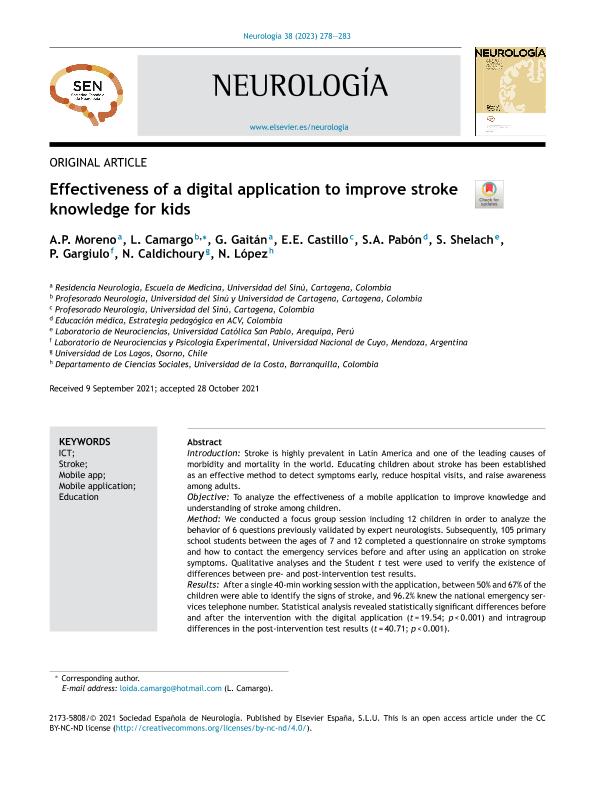Mostrar el registro sencillo del ítem
dc.contributor.author
Moreno, A .P.
dc.contributor.author
Camargo, L.
dc.contributor.author
Gaitán, G.
dc.contributor.author
Castillo, E. E.
dc.contributor.author
Pabón, S. A.
dc.contributor.author
Shelach, S.
dc.contributor.author
Gargiulo, Pascual Angel

dc.contributor.author
Caldichoury, N.
dc.contributor.author
López, N.
dc.date.available
2024-01-03T15:52:48Z
dc.date.issued
2023-05
dc.identifier.citation
Moreno, A .P.; Camargo, L.; Gaitán, G.; Castillo, E. E.; Pabón, S. A.; et al.; Effectiveness of a digital application to improve stroke knowledge for kids; Elsevier; Neurología; 38; 4; 5-2023; 278-283
dc.identifier.issn
2173-5808
dc.identifier.uri
http://hdl.handle.net/11336/222317
dc.description.abstract
Introducción: El ictus es muy prevalente en Latinoamérica y constituye una de las principales causas de morbimortalidad a nivel mundial. Se ha sugerido que ensenar ˜ a los ninos ˜ a reconocer los primeros síntomas de ictus puede ayudar a reducir el número de ingresos por esta enfermedad y a concienciar a la población adulta. Objetivo: Analizar la efectividad de una aplicación móvil para aumentar el conocimiento del ictus en los ninos. ˜ Método: Llevamos a cabo una sesión con un grupo focal de 12 ninos ˜ para analizar el comportamiento de 6 preguntas previamente validadas por un grupo de neurólogos expertos. Posteriormente, administramos un cuestionario sobre síntomas de ictus y servicios de emergencias a 105 ninos ˜ de entre 7 y 12 anos ˜ en dos momentos diferentes: antes y después de usar la aplicación sobre síntomas de ictus. Se realizaron análisis cualitativos y se aplicó la prueba t de Student para confirmar la presencia de diferencias en las respuestas al cuestionario antes y después de la intervención. Resultados: Tras una única sesión de 40 minutos con la aplicación, entre el 50% y el 67% de los ninos ˜ eran capaces de identificar los síntomas de ictus y el 96,2% se sabían el número de teléfono de emergencias. El análisis estadístico reveló diferencias estadísticamente significativas entre los resultados del cuestionario antes y después de la intervención (t = 19,54; P < 0,001), así como diferencias intragrupo en los resultados postintervención (t = 40,71; P < 0,001). Conclusión: Los ninos ˜ que utilizaron nuestra aplicación acabaron sabiendo más sobre los síntomas de ictus y cómo actuar.
dc.description.abstract
Introduction: Stroke is highly prevalent in Latin America and one of the leading causes ofmorbidity and mortality in the world. Educating children about stroke has been establishedas an effective method to detect symptoms early, reduce hospital visits, and raise awarenessamong adults.Objective: To analyze the effectiveness of a mobile application to improve knowledge andunderstanding of stroke among children.Method: We conducted a focus group session including 12 children in order to analyze thebehavior of 6 questions previously validated by expert neurologists. Subsequently, 105 primaryschool students between the ages of 7 and 12 completed a questionnaire on stroke symptomsand how to contact the emergency services before and after using an application on strokesymptoms. Qualitative analyses and the Student t test were used to verify the existence ofdifferences between pre- and post-intervention test results.Results: After a single 40-min working session with the application, between 50% and 67% of thechildren were able to identify the signs of stroke, and 96.2% knew the national emergency servicestelephone number. Statistical analysis revealed statistically significant differences beforeand after the intervention with the digital application (t = 19.54; p < 0.001) and intragroup differences in the post-intervention test results (t = 40.71; p < 0.001).Conclusion: Primary school children who used our digital application increased their knowledge,understanding, and learning of stroke symptoms.
dc.format
application/pdf
dc.language.iso
eng
dc.publisher
Elsevier

dc.rights
info:eu-repo/semantics/openAccess
dc.rights.uri
https://creativecommons.org/licenses/by-nc-nd/2.5/ar/
dc.subject
TIC
dc.subject
ICTUS
dc.subject
APP
dc.subject
APLICACIÓN
dc.subject
EDUCACIÓN
dc.subject.classification
Neurología Clínica

dc.subject.classification
Medicina Clínica

dc.subject.classification
CIENCIAS MÉDICAS Y DE LA SALUD

dc.title
Effectiveness of a digital application to improve stroke knowledge for kids
dc.title
Efectividad de una aplicación móvil para mejorar el conocimiento sobre los síntomas de ictus en una población pediátrica de Colombia
dc.type
info:eu-repo/semantics/article
dc.type
info:ar-repo/semantics/artículo
dc.type
info:eu-repo/semantics/publishedVersion
dc.date.updated
2024-01-03T12:43:26Z
dc.journal.volume
38
dc.journal.number
4
dc.journal.pagination
278-283
dc.journal.pais
España

dc.description.fil
Fil: Moreno, A .P.. Universidad de Sinú; Colombia
dc.description.fil
Fil: Camargo, L.. Universidad de Sinú; Colombia. Universidad de Cartagena; Colombia
dc.description.fil
Fil: Gaitán, G.. Universidad de Sinú; Colombia
dc.description.fil
Fil: Castillo, E. E.. Universidad de Sinú; Colombia
dc.description.fil
Fil: Pabón, S. A.. Universidad de Sinú; Colombia
dc.description.fil
Fil: Shelach, S.. Universidad Católica de San Pablo; Perú
dc.description.fil
Fil: Gargiulo, Pascual Angel. Universidad Nacional de Cuyo; Argentina. Consejo Nacional de Investigaciones Científicas y Técnicas. Centro Científico Tecnológico Conicet - Mendoza; Argentina
dc.description.fil
Fil: Caldichoury, N.. Universidad de Los Lagos; Chile
dc.description.fil
Fil: López, N.. Universidad de la Costa.; Colombia
dc.journal.title
Neurología
dc.relation.alternativeid
info:eu-repo/semantics/altIdentifier/url/https://linkinghub.elsevier.com/retrieve/pii/S2173580823000044
dc.relation.alternativeid
info:eu-repo/semantics/altIdentifier/doi/http://dx.doi.org/10.1016/j.nrleng.2021.10.006
Archivos asociados
